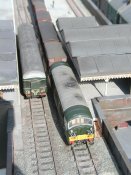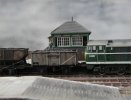Saffron Street is a model of a fictitious station in north west
London in about 1964 where diesels have replaced most of the steam
workings. The station is all but closed, only remaining open to this
point to serve a small yard and industries. Most of the
workings are freight, although infrequent passenger train or a
multiple unit working may be seen at times, trains from most regions
can be seen including London Transport. The railway is on arches with
streets below, the area is smoke stained and dirty but pastel shades
on cars of the period add a touch of colour and are perhaps are a
taste of things to come. This is the year of the Profumo affair, The
Beatles Hard Days Night and a general election, a time of change indeed.
The layout has been constructed by members of the Risborough &
District Model Railway Club, to see if a small layout built to P4
standards within an urban location and diesels as the main motive
power could be achieved, as this was thought to be something that was
rarely modelled. The focus of the design was to be on the atmosphere
and period, the opening paragraph above hopefully gives an idea of
what we were trying to achieve.
The layout measures 15 feet by 2 feet wide and is free standing at 3
foot 10 inches. It is built to a scale of 4mm to the foot running on
a gauge of 18.83mm (P4) and can be transported in two small cars, it
requires three operators who control the layout from the rear
although there is provision for a controller to be plugged into the
front of the layout so one person can talk to the public whilst
operating. At present there is no independent lighting although
hopefully this will be amended within the coming months. Required for
exhibition use is as a standard mains power point (double if
possible) and a small table to place stock and boxes on (this can be
at the rear or side of the layout).
Click Here for Black and White Photos
Saffron Street is not yet fully complete. All the trackwork
is finished and working, also a number of structures and scenic
features are in place but a large number of buildings are still
required to complete the street scenes that cluster around the
railway arches. Sixteen houses, two pubs, a row of shops and an art
deco cinema are some of the buildings that are being made or needed,
and will be scratch built, the time scale for finishing all this work
will hopefully be within the next 18 months.
All stock is either kit, scratch built or heavily modified and
re-wheeled R.T.R. which is either compensated or sprung using tiny
leaf springs which is now the favoured method for any new stock
built. Alex Jackson automatic couplings are used on each rake of two
or four wagons, these are operated by electromagnets. Control is via
two pentrollers and turnouts are operated by both mechanical linkages
and slow acting point motors from a 12 lever frame, which will
control the signals when they are installed.
|














